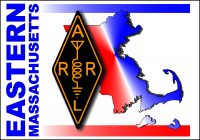Date and Timeframe of Exercise
Saturday February 24th, 2006
Start Time 10 AM
End Time: 12 PM
Duration: 2 Hours
-Please allow time for setup/take down of any equipment during this exercise.
Purpose
Eastern Massachusetts ARES will participate in the Operation Communications Pathways exercise. This exercise will be more simplistic than previous Eastern Massachusetts ARES exercises. The goal of this exercise will be to test out pathways to a handful of major repeaters and also via simplex. The intent is to involve new ARES personnel who may be insecure in participating in a full blown exercise and to also concentrate on some deficiencies exposed in the last exercise particularly around simplex connectivity across the section. Message traffic will not be emphasized in this exercise but if time allows, Hams are encouraged to pass message traffic especially via simplex. The message could be sent tactically or formally giving the signal report of the main control point or secondary control point as required.
Concept of Operations
The concept of operations for this exercise will be to have Amateurs start on one 2 meter repeater frequency and then move on to other repeater frequencies to see if they can reach them following a specific schedule. The operations will end with an attempt to reach all stations participating on Simplex using a series of relays where appropriate. Below is a rough schedule of repeaters and simplex frequencies to be tested:
1000-1020 AM: 145.23-Boston Repeater (PL: 88.5 Hz)
1020-1040 AM: 146.64-Waltham Repeater (No PL)
1040-1100 AM: 145.47-Danvers Repeater (PL: 136.5 Hz)
1100-1120 AM: 145.49-Fairhaven Repeater (PL: 67.0 Hz)
1120 AM-Noon: 147.42-Simplex*
*–KD1CY @ W1AEC which is the SEMARA Club will act as the main control point on Simplex and will hand the control point off to other main stations as they come on the frequency. If you are a participating station and do not hear any traffic on simplex, be patient, and listen carefully to see if one of the other control points that will be established live during the exercise can hear you.
The HF Net will be active on either 3943 KHz or 7245 KHz depending on propagation and serve as a command/control point for those that cannot make contact on a designated repeater to fall back to until they move on to the next frequency and to let stations know what repeater the net is on or what repeater the net has moved to if in transition. In addition, the EchoLink/IRLP New England
Reflector (EchoLink Conference Server Node: 9123/IRLP reflector #9123) will also serve as a command/control point similar to what will be done on HF. We also will attempt to get information on where we move the body of stations passed via WinLink and Packet as another means to track where all the stations are active.
We ask all participating stations to try all 5 frequencies even if they feel they cannot reach a specific repeater or don’t have reasonable simplex coverage. It will be a good way to determine the range of your station and holes in coverage when using this specific set of repeaters or Simplex. Use HF, VoIP and Digital modes as control points.
If you are participating and cannot or do not feel you can hit any of the slated repeaters, simplex or control points on HF, VoIP or digital modes, please contact your local ARES EC/DEC or SEC so we can assist you in some way to participate in this exercise.
The following are important Packet Frequencies on VHF/UHF and HF for this drill where message traffic on what frequency is currently active will be passed to with enough participating stations:
WinLink Frequencies:
145.75: Main WinLink Frequency for Mass. State EOC and MEMA Region I
3.591 USB: Main HF WinLink Frequency for Mass. State EOC and MEMA
Region I. Region I setup currently down due to interference issues.
Packet Frequencies:
145.01: Packet Frequency supporting MEMA Regions and State EOC
145.09: BBS infrastructure supporting MEMA and NWS main Packet Freq.
There are additional local frequencies that maybe utilized in this drill at your local town/city level or at a regional level as another means to follow where the net goes for stations who may not hit the selected repeaters. Please contact your ARES DEC or EC for further information on additional frequencies that maybe utilized in your specific area during the drill.
Respectfully Submitted,
Robert Macedo (KD1CY)
ARES SKYWARN Coordinator
Eastern Massachusetts ARES Section Emergency Coordinator
Pager #: (508) 354-3142
Home Phone #: (508) 994-1875 (After 6 PM)
Home/Data #: (508) 997-4503 (After 6 PM)
Work Phone #: 1-800-445-2588 Ext.: 72929 (8 AM-5 PM)
Email Address: rmacedo@rcn.com
http://users.rcn.com/rmacedo
1 1

